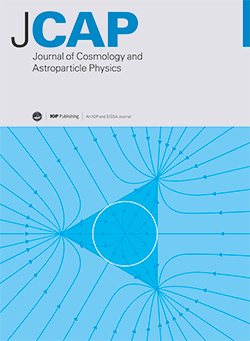星系双谱中的相对论效应解耦局部原初非高斯性
IF 5.9
2区 物理与天体物理
Q1 ASTRONOMY & ASTROPHYSICS
Journal of Cosmology and Astroparticle Physics
Pub Date : 2025-07-16
DOI:10.1088/1475-7516/2025/07/055
引用次数: 0
摘要
即将到来的星系调查旨在以前所未有的精度、深度和天空覆盖绘制宇宙地图。星系双谱是信息的主要来源,因为它使我们能够探测原始非高斯性(PNG),这是区分各种膨胀模型的关键因素。在局部PNG最强的尺度上,多普勒和其他相对论效应变得重要,需要包括在内。与单示踪剂功率谱不同,在双谱中,前阶虚多普勒项不会被抵消,从而留下一个确凿的虚偶极子信号。我们研究了星系双光谱中相对论性和局部PNG贡献的可探测性和重要性。我们计算了检测双谱光锥投影效应的信噪比。此外,我们对局部PNG参数、fNL和相对论修正的参数化幅度进行了信息矩阵预测。最后,我们量化了由于忽略相对论效应而导致的fNL测量偏差。我们的研究结果表明,在即将到来的光谱调查规范中,一阶和二阶相对论效应的探测是有希望的,并且在很大程度上不受fNL不确定性的影响。相反,我们首次表明,忽略星系双谱中的相对论修正会导致fNL的探测值偏移>1.5σ(fNL),这突出了在我们的建模中包括相对论效应的重要性。本文章由计算机程序翻译,如有差异,请以英文原文为准。
Decoupling local primordial non-Gaussianity from relativistic effects in the galaxy bispectrum
Upcoming galaxy surveys aim to map the Universe with unprecedented precision, depth and sky coverage. The galaxy bispectrum is a prime source of information as it allows us to probe primordial non-Gaussianity (PNG), a key factor in differentiating various models of inflation. On the scales where local PNG is strongest, Doppler and other relativistic effects become important and need to be included. Unlike for the single-tracer power spectrum, the leading order imaginary Doppler term does not cancel out in the bispectrum, leaving a smoking gun imaginary dipole signal. We investigate the detectability and importance of relativistic and local PNG contributions in the galaxy bispectrum. We compute the signal-to-noise ratio for the detection of lightcone projection effects in the bispectrum. Furthermore, we perform information matrix forecasts on the local PNG parameter, fNL, and on the parametrised amplitudes of the relativistic corrections. Finally, we quantify the bias on the measurement of fNL that arises from neglecting relativistic effects. Our results show that detections of both first- and second-order relativistic effects are promising with forthcoming spectroscopic survey specifications — and are largely unaffected by the uncertainty in fNL. Conversely, we show for the first time that neglecting relativistic corrections in the galaxy bispectrum can lead to a shift >1.5σ(fNL) on the detected value of fNL, highlighting the importance of including relativistic effects in our modelling.
求助全文
通过发布文献求助,成功后即可免费获取论文全文。
去求助
来源期刊

Journal of Cosmology and Astroparticle Physics
地学天文-天文与天体物理
CiteScore
10.20
自引率
23.40%
发文量
632
审稿时长
1 months
期刊介绍:
Journal of Cosmology and Astroparticle Physics (JCAP) encompasses theoretical, observational and experimental areas as well as computation and simulation. The journal covers the latest developments in the theory of all fundamental interactions and their cosmological implications (e.g. M-theory and cosmology, brane cosmology). JCAP''s coverage also includes topics such as formation, dynamics and clustering of galaxies, pre-galactic star formation, x-ray astronomy, radio astronomy, gravitational lensing, active galactic nuclei, intergalactic and interstellar matter.
 求助内容:
求助内容: 应助结果提醒方式:
应助结果提醒方式:


